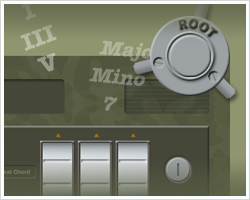In music theory and in communication between musicians, chords are often represented with roman numerals which indicate the function of each chord within a particular key. Because Arabic numerals are generally used to indicate scale degrees, Roman numerals were adopted for chords in order to make an explicit distinction and improve clarity. If you see '1' in the key of C Major, you know it is referring to the tonic tone (C), while the Roman numeral 'I' refers to the tonic chord (C Major).
Whenever you see a Roman numeral representation of a chord, you know straightaway that the root of the chord has the same scale degree number (Arabic number) as the Roman numeral for the chord. Hence the IV chord in the key of C Major has as its root the 4 degree of the C Major scale (F), and the VIm chord in the key of C Major will have the tone A as its root.
There are different ways to represent various types of chords. Some musicians like to use lowercase Roman numerals for minor chords. This is especially common in classical music and traditional music theory textbooks. Other people prefer to use all uppercase Roman numerals, and indicate the type of chord explicitly by adding 'm', 'dim', 'aug', etc. This is the approach that we have adopted for our games and lessons. Here are the basic (most common) chords in Roman numeral format for the key of C Major:
| I | IIm | IIIm | IV | V | VIm | VIIdim |
| C | Dm | Em | F | G | Am | Bdim |
Number Blaster will help you to quickly place chords in their Roman numeral context for different keys. Chord Locks will also give you extensive practice at identifying various type of chords by ear as well as by roman numeral.


